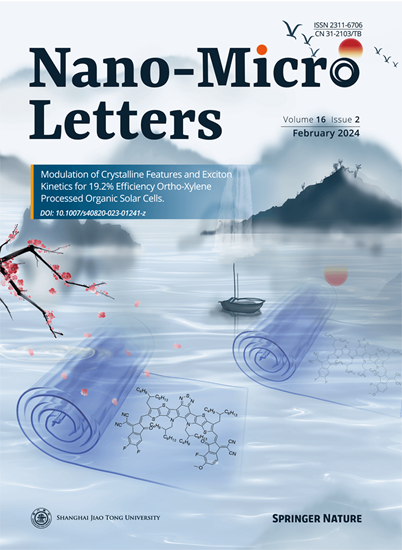Multifunctional MXene for Thermal Management in Perovskite Solar Cells.
IF 36.3
1区 材料科学
Q1 Engineering
引用次数: 0
Abstract
Perovskite solar cells (PSCs) have emerged as promising photovoltaic technologies owing to their remarkable power conversion efficiency (PCE). However, heat accumulation under continuous illumination remains a critical bottleneck, severely affecting device stability and long-term operational performance. Herein, we present a multifunctional strategy by incorporating highly thermally conductive Ti3C2TX MXene nanosheets into the perovskite layer to simultaneously enhance thermal management and optoelectronic properties. The Ti3C2TX nanosheets, embedded at perovskite grain boundaries, construct efficient thermal conduction pathways, significantly improving the thermal conductivity and diffusivity of the film. This leads to a notable reduction in the device's steady-state operating temperature from 42.96 to 39.97 °C under 100 mW cm-2 illumination, thereby alleviating heat-induced performance degradation. Beyond thermal regulation, Ti3C2TX, with high conductivity and negatively charged surface terminations, also serves as an effective defect passivation agent, reducing trap-assisted recombination, while simultaneously facilitating charge extraction and transport by optimizing interfacial energy alignment. As a result, the Ti3C2TX-modified PSC achieve a champion PCE of 25.13% and exhibit outstanding thermal stability, retaining 80% of the initial PCE after 500 h of thermal aging at 85 °C and 30 ± 5% relative humidity. (In contrast, control PSC retain only 58% after 200 h.) Moreover, under continuous maximum power point tracking in N2 atmosphere, Ti3C2TX-modified PSC retained 70% of the initial PCE after 500 h, whereas the control PSC drop sharply to 20%. These findings highlight the synergistic role of Ti3C2TX in thermal management and optoelectronic performance, paving the way for the development of high-efficiency and heat-resistant perovskite photovoltaics.钙钛矿太阳能电池热管理的多功能MXene。
钙钛矿太阳能电池(PSCs)由于其卓越的功率转换效率(PCE)而成为一种有前途的光伏技术。然而,持续照明下的热积累仍然是一个关键的瓶颈,严重影响器件的稳定性和长期运行性能。在此,我们提出了一种多功能策略,通过将高导热Ti3C2TX MXene纳米片结合到钙钛矿层中,同时增强热管理和光电子性能。将Ti3C2TX纳米片嵌入钙钛矿晶界,构建了高效的热传导通道,显著提高了薄膜的导热性和扩散率。这导致器件在100 mW cm-2照明下的稳态工作温度从42.96°C显著降低到39.97°C,从而减轻了热引起的性能下降。除了热调节外,Ti3C2TX具有高导电性和带负电荷的表面末端,还可以作为有效的缺陷钝化剂,减少陷阱辅助重组,同时通过优化界面能排列促进电荷的提取和传输。结果表明,ti3c2tx改性的PSC在85℃、30±5%相对湿度条件下经过500 h的热老化后,PCE达到了25.13%的最高水平,并表现出了出色的热稳定性,PCE保持了80%。(相比之下,对照组PSC在200小时后仅保留58%。)此外,在N2气氛中连续进行最大功率点跟踪时,500 h后,ti3c2tx改性PSC的PCE仍保持在初始PCE的70%,而对照PSC的PCE则急剧下降至20%。这些发现突出了Ti3C2TX在热管理和光电子性能方面的协同作用,为开发高效耐热钙钛矿光伏电池铺平了道路。
本文章由计算机程序翻译,如有差异,请以英文原文为准。
求助全文
约1分钟内获得全文
求助全文
来源期刊

Nano-Micro Letters
NANOSCIENCE & NANOTECHNOLOGY-MATERIALS SCIENCE, MULTIDISCIPLINARY
CiteScore
32.60
自引率
4.90%
发文量
981
审稿时长
1.1 months
期刊介绍:
Nano-Micro Letters is a peer-reviewed, international, interdisciplinary, and open-access journal published under the SpringerOpen brand.
Nano-Micro Letters focuses on the science, experiments, engineering, technologies, and applications of nano- or microscale structures and systems in various fields such as physics, chemistry, biology, material science, and pharmacy.It also explores the expanding interfaces between these fields.
Nano-Micro Letters particularly emphasizes the bottom-up approach in the length scale from nano to micro. This approach is crucial for achieving industrial applications in nanotechnology, as it involves the assembly, modification, and control of nanostructures on a microscale.
 求助内容:
求助内容: 应助结果提醒方式:
应助结果提醒方式:


